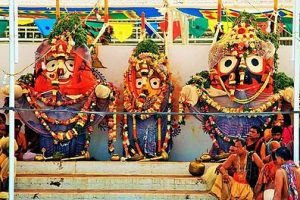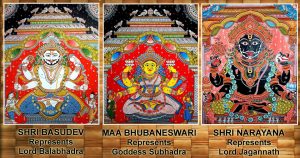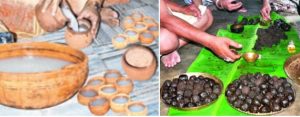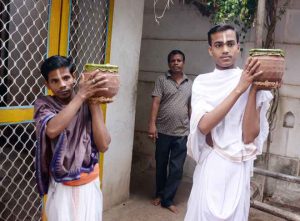Bhubaneswar: The sibling deities from Puri’s Jagannath Temple have recovered after a two-week-long herbal treatment.
They had fallen ill after Snana Purnima on June 21, a ritual bath with 108 pitchers of herbal and aromatic water, a prelude to the nine-day Rath Yatra, and retired to the Anasara Ghar (asylum for the sick).

“The final phase of the rituals were completed on Saturday. The deities have recovered completely from their illness,” said Jagannath Temple servitor Binayak Das Mohapatra on Sunday.
So, what really happens at the Srimandir during these two weeks as the Lords recuperate?
According to Pratihari Sevaka Surya Narayan Gochhikar, the ailing deities are offered only fruits and water, mixed with cheese and ‘Dasamula’ (herbal) medicines while Daitapati Sevayats perform secret rituals to cure them.
Patti Dians
During ‘Anasara’ period, Patti Dians, which are traditional Pattachitra paintings of the three deities in striking colours, are worshiped at the temple. In Patti Dians, Lord Jagannath is depicted as Lord Vishnu, Devi Subhadra as Adishakti and Lord Balabhadra as Lord Shiva. Dasaavatara (ten incarnations of Lord Vishnu) idol is also worshiped during this period.

Mangala Alati and Abakasha Niti rituals are performed near Patti Dians. Gopala Ballava Bhoga is offered to them and the Dasaavatara idol, following which Sakala Dhupa ritual is observed, followed by Bhoga Mandap and Madhyanaa Dhupa rituals.
Anasara Pindi and Rituals
The sibling deities stayed in Anasara Pindi during this period and were offered Pana Bhoga by Pati Mahapatra to help them heal.
Medicines, including Jhuna, Kaintha Atha and other herbs, are also offered to the deities by the Daitapatis.

Phuluri Tela
Bada Odia Mutt, which is the Adi Pitha of Atibadi Jagannath Das, prepares Puluri Tela (oil) for the deities.
It is applied on the whole body of idols. The oil is made using flowers such as Ketaki, Malli, Boula and Champa, roots, sandalwood powder, camphor, rice and grains. The main ingredient is Sesame oil. Phuluri Tela is applied on the wooden idols on Ashtami to protects them from moths and insects.

The oil is preserved in an earthen pot and in a pit under the soil after Rath Yatra for near about a year.
Other Rituals
After the oil message, Kaintha Atha (woodapple) is applied on the deities and idols are covered with new clothes. Since the idols are made of wood, Badagrahies check the idols minutely during this period.
Likewise, Khadi (primer) is applied on the deities on the Khadilagi Ekadasi.
Chaka Bije Niti is then held on Dasami when deities are said to regain balance and feel better after sitting properly on the wheels.
Khadilagi and Rakta Bastra lagi rituals are held on Ekadasi.
On Dwadasi, Raja Prasad Bije Niti is held. In this ritual, the Daitapatis take all the items of sibling deities to the Gajapati Maharaja, who is the first servitor of Lord Jagannath, and inform him about they having been cured.
On Treyadashi, Ghanalagi ritual is held. Ghana, which is made of ropes, is tied to the deities during this ritual, which takes over 10 to 12 hours.
It is followed by Banakalagi ritual, when the deities are painted in a new colour.
Notably, no chemicals are used in the colours. The main ingredient is Kasturi Nabhi (musk collected from a stag’s navel).
Kasturi Nabhi
Kasturi Nabhi, which is very scarce, is brought from Nepal. It is then mixed with chemical-free colours, which add brightness to the idols of the deities and protect them from insects.
As per tradition, the King of Nepal is also a Sevak of Lord Jagannath, just as the Gajapati of Puri is.
Nabajauban Darshan
After Ghanalagi and Banakalagi rituals, the deities are decked up in Nabajoubana Besha on Amabasya. “It means, the deities are cured and ready to flaunt their rejuvenated youth to the devotees,” said Gocchhikar.
Overall, the wooden idols are checked to see if there is any damage. Old layers are removed and replaced with new ones during ‘anasara’, Gocchhikar said.
In other words, it is annual maintenance of wooden idols with natural preservative.


